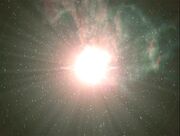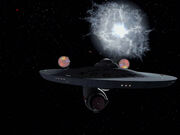No edit summary |
Deevolution (talk | contribs) m (+img) |
||
| Line 1: | Line 1: | ||
[[Image:Supernova.jpg|thumb|A supernova explosion]] |
[[Image:Supernova.jpg|thumb|A supernova explosion]] |
||
| + | [[Image:Beta Niobe nova remastered.jpg|thumb|[[Beta Niobe]] goes nova in [[2268]]]] |
||
A '''supernova''' is a massive explosion that occurs upon the death of an old [[star]]. When a massive star runs out of nuclear fuel, the star collapses under [[gravity]]. The resulting shockwave blows the outer layers of the star into space, possibly leaving a core that becomes either a [[neutron star]] or a [[black hole]] depending on the remaining mass. A different kind of supernova occurs (more rarely in our [[Milky Way Galaxy]]) when a [[white dwarf]] star in a tight [[Multiple star system|binary system]] swallows material from her companion, eventually becoming too massive and collapsing. |
A '''supernova''' is a massive explosion that occurs upon the death of an old [[star]]. When a massive star runs out of nuclear fuel, the star collapses under [[gravity]]. The resulting shockwave blows the outer layers of the star into space, possibly leaving a core that becomes either a [[neutron star]] or a [[black hole]] depending on the remaining mass. A different kind of supernova occurs (more rarely in our [[Milky Way Galaxy]]) when a [[white dwarf]] star in a tight [[Multiple star system|binary system]] swallows material from her companion, eventually becoming too massive and collapsing. |
||
Revision as of 10:08, 22 April 2007

A supernova explosion

Beta Niobe goes nova in 2268
A supernova is a massive explosion that occurs upon the death of an old star. When a massive star runs out of nuclear fuel, the star collapses under gravity. The resulting shockwave blows the outer layers of the star into space, possibly leaving a core that becomes either a neutron star or a black hole depending on the remaining mass. A different kind of supernova occurs (more rarely in our Milky Way Galaxy) when a white dwarf star in a tight binary system swallows material from her companion, eventually becoming too massive and collapsing.
In the negative universe, a supernova is a dead star coming to life. (TAS: "The Counter-Clock Incident")
When stars explode, they emit an electrical magnetic pulse. This pulse can cause electro-magnetic devices such as computers to fail. An event of this kind took place in 2364 when a star in the Beta Magellan system supernovaed resulting in main computer failure on Bynaus. (TNG: "11001001")
A supernova which occured 600,000 years ago, during the Age of Makto, was responsible for the fall of the Tkon Empire. (TNG: "The Last Outpost")
In 2366, the star Beta Stromgren exploded as a supernova. The last stages of the star life were observed by the Enterprise-D while taking first contact with the creature Gomtuu. (TNG: "Tin Man")
Supernovae however generally occur only approximately once per century in the Milky Way Galaxy. As of the 24th century, only three Starfleet starships ever witnessed supernovae firsthand. The record for the closest observation was less than 10 billion kilometers and was set by the USS Voyager in 2373. (VOY: "The Q and the Grey")
In 2373, a number of supernovae occurred within a small region of the Delta Quadrant, as a result of the Q civil war. These supernovae were actually the result of spatial disruptions within the Q Continuum.
It was explained to Chakotay, by a female Q, "That each time a star implodes a negative density false vacuum is created, which actually sucks the surrounding matter into the Continuum."
The crew of the USS Voyager, acting on information provided by the female Q, used the explosion of one of these supernovae to enter the Continuum themselves, in order to rescue Q and Captain Janeway. (VOY: "The Q and the Grey")
- It is never clarified if the spatial disruptions in the Q-Continuum were created deliberately or merely side-effects of various Q weaponry, but only that the Q civil war, and Q's actions, were having galactic consequences.
